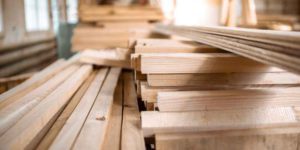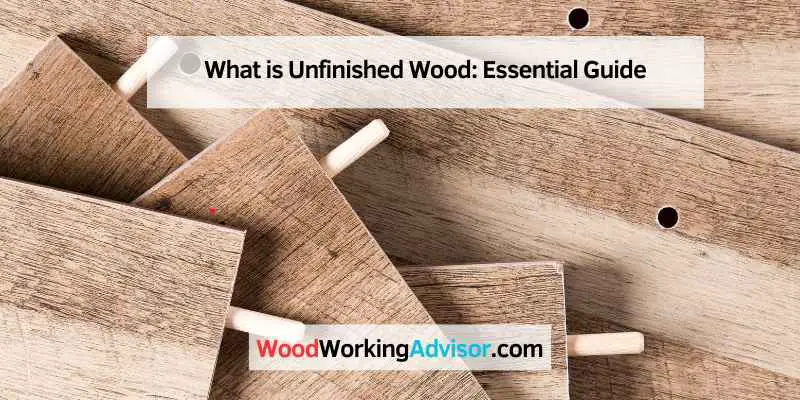Unfinished wood is wood that has not undergone any type of finishing process, such as staining or varnishing.
Differences
Unfinished wood refers to wood products that have not been treated with any surface protective coating or finish. This lack of surface treatment makes it more susceptible to damage from moisture, stains, and other environmental factors compared to finished wood. Understanding the differences between finished and unfinished wood is important when using wood products in various applications.
Finished Vs Unfinished Wood
Finished wood products have a protective coating applied to the surface, such as stain, varnish, or paint, to enhance durability and appearance. This coating not only protects the wood from moisture, stains, and wear but also provides a finished aesthetic to the wood surface. On the other hand, unfinished wood lacks this protective layer and is vulnerable to damage without additional treatment.
How To Identify Unfinished Wood
It is important to be able to identify unfinished wood, especially when purchasing wood products for a project. Some key indicators of unfinished wood include:
- The absence of a smooth and finished appearance on the surface
- The lack of a protective coating such as varnish or paint
- The natural, raw appearance of the wood grain
Additionally, unfinished wood may require sanding and sealing to achieve the desired finish, unlike finished wood products that are ready for use upon purchase.
In summary, understanding the differences between finished and unfinished wood is crucial for making informed decisions when using wood products in various projects. Whether it’s for furniture, flooring, or crafts, identifying and properly treating unfinished wood can prolong its lifespan and enhance its appearance.
Protection
Unfinished wood lacks a protective layer, making it susceptible to damage from elements like moisture and sunlight. Without treatment, unfinished wood may deteriorate quickly, requiring particular care to maintain its natural appearance and durability.
Risks Of Leaving Wood Unfinished
Leaving wood unfinished may give your furniture a natural, rustic look, but it also exposes it to various risks. Without a protective finish, unfinished wood is vulnerable to damage from light, dust, moisture, and water. This increased susceptibility can lead to stains, warping, and cracking.
Longevity Of Unfinished Wood
Untreated wood lacks the durability of pressure-treated lumber, as it does not have the same chemical preservatives. Consequently, when left unprotected against elements like rain or snow, unfinished wood can deteriorate quickly, often within just a few years. To ensure the longevity of unfinished wood, it is crucial to take appropriate measures for protection.
Applications
Unfinished wood furniture offers a raw and natural aesthetic that can suit various design styles. Crafted from bare wood, it allows for personalization through staining or painting processes. This type of furniture is versatile and can be customized to match any interior decor theme.
Integrating unfinished wood in home decor adds a touch of rustic charm and warmth to living spaces. From exposed beams and accent walls to wooden accents and furniture pieces, unfinished wood can create a cozy and inviting atmosphere. Its natural beauty brings a sense of organic elegance to any room.
Finishing Process
When it comes to unfinished wood, the finishing process plays a crucial role in enhancing its appearance and durability. Finishing Unfinished Wood is essential to protect the wood from external elements and prolong its lifespan while adding a touch of customization.
Finishing Unfinished Wood
Finishing unfinished wood involves applying different treatments like staining, sealing, or painting to enhance its visual appeal and protect it from moisture, sunlight, or wear and tear.
Benefits Of Customization
- Customizing unfinished wood allows you to choose the desired stain color and finish, giving you creative control over the final look.
- Personalization through customization enables you to match the unfinished wood piece with your existing decor and overall style.
- Enhanced aesthetics and unique finishes can be achieved by customizing the unfinished wood to suit your preferences.
Market
Unfinished wood refers to raw wood planks that require sanding, staining, and sealing on-site after installation. This allows for greater customization, as individuals can choose the desired stain color, sheen level, and overall appearance. Unfinished wood furniture, for example, has been put together by craftsmen but still needs a finish, such as stain or varnish, to be applied.
When it comes to unfinished wood, there is a thriving market for DIY enthusiasts and home decor lovers. It offers a wide variety of wood options for those who love the satisfaction of completing a project from scratch. Unfinished wood allows individuals to showcase their creativity by selecting the perfect finish and style that aligns with their vision.
Buying Unfinished Wood
If you are considering buying unfinished wood, there are a few factors to keep in mind. First, it is essential to determine the quality of the wood you are purchasing. Look for reputable suppliers who offer high-quality materials that will withstand the test of time.
Next, consider the type of wood that best suits your project. Common options include pine, oak, cedar, and maple, each with its unique characteristics and grain patterns. Research the properties of each type to ensure you select the best wood for your needs.
Additionally, take into account the dimensions of the wood pieces you require. Measure your project’s specifications to ensure that the unfinished wood you purchase is the right size and shape. This will save you time and effort later on.
Best Practices For Selecting Unfinished Wood
When selecting unfinished wood, there are several best practices to follow:
- Inspect the wood for any visible defects or damage, such as knots or cracks. Avoid purchasing wood with significant flaws as it may compromise the stability and appearance of your finished project.
- Consider the moisture content of the wood. It is important to select wood that has been properly dried to prevent warping or shrinking after applying a finish.
- Ask for samples or swatches if possible. This will give you a better idea of how the wood will look once it is finished and help you make an informed decision.
- Choose a reputable supplier who offers a wide range of unfinished wood options. This will give you the flexibility to find the perfect match for your project.
By following these best practices, you can ensure that you are purchasing high-quality unfinished wood that will result in a beautiful and durable finished product.
Practical Considerations
When it comes to choosing the right wood for your furniture or home decor projects, there are several practical considerations to keep in mind. One of these considerations is whether to leave the wood unfinished or apply a finish. Unfinished wood can add a natural and rustic charm to your space, but is it practical? Let’s explore the practicality of unfinished wood in different situations.
Can Wood Be Left Unfinished?
The answer is yes, wood can be left unfinished. Bare wood retains its natural beauty and texture, giving your furniture a unique and organic appeal. However, it’s important to note that leaving wood unfinished exposes it to potential damage from elements such as light, dust, moisture, and water. These elements can lead to stains, warping, and cracking, compromising the durability and lifespan of the wood.
Situations Suitable For Unfinished Wood
While there are drawbacks to leaving wood unfinished, there are certain situations where it can be a suitable and practical choice. Here are a few instances where unfinished wood may be the right option:
- Indoor Use: If you’re using the wood for indoor furniture or decor, such as shelves or picture frames, leaving it unfinished is generally acceptable. Indoor environments offer better protection against elements like rain and intense sunlight, reducing the risk of damage.
- Low-Traffic Areas: Unfinished wood can work well in low-traffic areas where the risk of damage is minimal. For example, a decorative accent piece in a living room or a statement piece in a bedroom can retain its natural beauty without much risk.
- Periodic Maintenance: If you’re willing to commit to periodic maintenance, such as dusting and occasional touch-ups, unfinished wood can remain in good condition for a longer period. Regular care can help protect the wood and maintain its natural appeal.
It’s important to note that when considering unfinished wood, you should take into account the specific type of wood you’re using. Some wood species may be more resistant to damage than others, making them better suited for unfinished projects.
In conclusion, while there are practical considerations to leaving wood unfinished, it can be a suitable option in certain situations. Indoor use, low-traffic areas, and a commitment to periodic maintenance are factors to consider when deciding whether to leave wood unfinished. Ultimately, the choice between finished and unfinished wood comes down to personal preference and the specific requirements of your project.
Popular Brands
Unfinished wood refers to wood that has not been coated with any protective finish or paint, allowing for a natural look. It requires additional finishing like sanding, staining, and sealing. While it gives furniture a natural aesthetic, it’s more susceptible to damage from elements like moisture and light.
Unfinished Wood Co
Unfinished Wood Co offers a wide variety of high-quality unfinished wood products.
Mill Stores And Unfinished Wood
Mill Stores provides premium unfinished wood furniture and home decor items.

Frequently Asked Questions For What Is Unfinished Wood
What Is The Difference Between Finished Wood And Unfinished Wood?
Finished wood has a protective coating, like wax or varnish, creating a barrier on the surface. Unfinished wood lacks this layer, leaving it more susceptible to damage.
How Can You Tell If Wood Is Unfinished?
Unfinished wood lacks a protective surface layer created by finishes like wax. Leaving wood unfinished exposes it to elements like light, moisture, and stains, making it more susceptible to damage. Untreated wood deteriorates quickly and may last only a few years.
Unfinished furniture is assembled but requires a finish like stain or varnish.
Is It Ok To Leave Wood Unfinished?
Leaving wood unfinished may expose it to elements like light, moisture, and dust, leading to potential damage such as staining, warping, and cracking. Consider finishing wood to protect and prolong its lifespan.
How Long Does Unfinished Wood Last?
Unfinished wood, when exposed to the elements, lasts only a few years due to lack of protective treatment.
Conclusion
Unfinished wood offers a natural and customizable option for DIY enthusiasts and home decor lovers. The primary difference between finished and unfinished wood lies in the additional protective layer added by the finish. Leaving wood unfinished can preserve its natural look, but it also exposes it to potential damage from elements like moisture and light.
However, unfinished wood furniture can still be a viable option as long as it is protected from harsh conditions. When choosing between finished and unfinished wood, consider your specific needs and the level of customization desired for your project.


